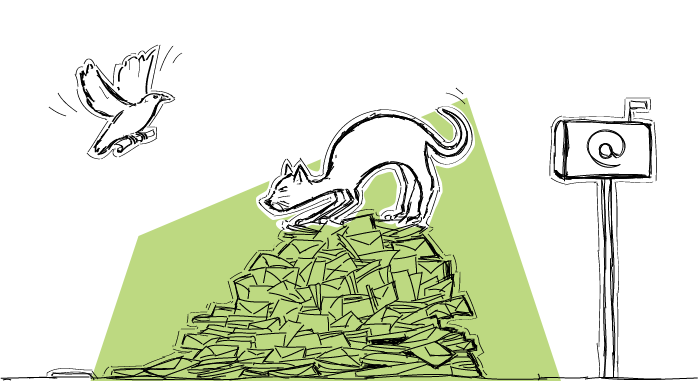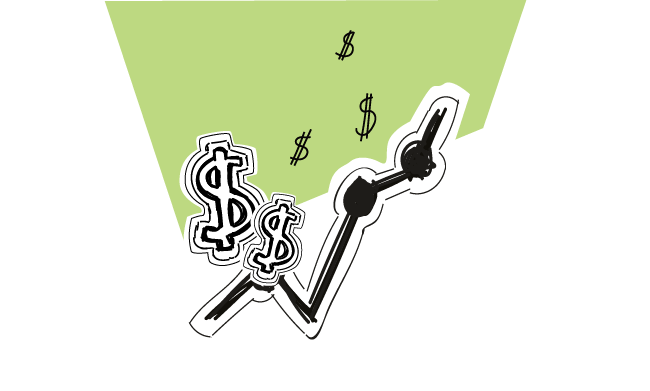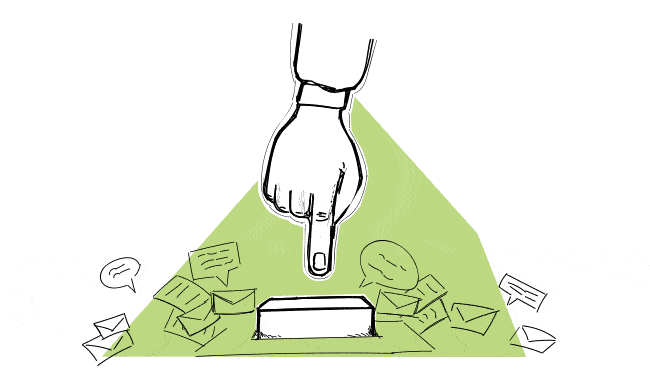Whereas a well-crafted subject is key for boosting our opening rates, the CTA (call to action) is the key to boosting the reply rates. That’s the sentence, or a question, the addressee reads at the end of our message. That’s the part that persuades them to undertake some action – send us a reply, click the provided link, sign up for a trial.
If you want to know how to write effective CTAs, keep reading.
If you feel like learning more about cold email copywriting, check out the Woodpecker cold email guide.
A step-by-step guide to writing a persuasive cold email CTA
Think of a CTA in terms of causality. It should be a trigger, which causes a specific action that leads to achieving your pre-defined aim. For a CTA to trigger the right action, and thus bring the expected result, it’s very important how we form our persuasive request. Here are the steps we should keep in mind when crafting our cold email CTA.
#1. Define the purpose of the email
“What’s the goal of my email?” is the second question to ask ourselves when writing a cold email (the first one is ‘Who is the addressee of the email?’ – more on that here and here). The whole message should be consistent with that purpose and a good CTA should clarify this goal within a single sentence.
The CTA should be the answer to a crucial question our addressee will be asking themselves, that is: “What do they want from me?”
Many cold emails I get fail to answer that question. And when a quite well-constructed message fails because of a too blurry CTA, or even worse – lack thereof, that’s just sad. If the addressee is not sure what we want from them after all, they most probably won’t enter the conversation.
#2. Make the CTA persuasive and specific
Have a look at your email draft and ask yourself: “Does my addressee know exactly what I want from them?” The role of a CTA is to specify the next step we would like our prospects to take. There should be no doubt about what we’re asking them to do, be it meeting in person, having a call or leaving a review. For a CTA to persuade the addressee to take the right action, we need to be as specific as it gets in constructing our request.
For better understanding, let’s see how a CTA may be worded to match various intents and persuade the addressees to take action.
Call invite
When it comes to sales emails, the goal is usually to set up a meeting with a prospect to talk about their business needs and our solution. In this case, a CTA could look somewhat like one of these examples:
-
Would you be interested in a phone chat so I could tell you more?
-
Would you be available for a phone chat next week?
-
Would you be available for a 10-minute phone chat next week?
-
Would you be able to chat on the phone for 10 minutes next week on Mon or Thur morning?
Which question is a prospect more likely to answer? Based on our experience, it’s the last one. Here’s why.
Have you noticed how each version includes more and more details? That’s because the addressee will be more willing to agree if they know exactly what they’re agreeing to. It’s also a matter of convenience – the easier and faster it is to answer the question, the more likely it is that a prospect will do it. For this reason, it’s important to give the prospects an estimated duration of the call or even suggest the means of communication.
Let’s have a look at one more example below:
When is the best time for you to talk about this for 10 minutes?
To answer such a question, a prospect has to reach to their calendar and choose a date themselves. That will sometimes work. Nonetheless, we can make the decision easier by giving them a limited choice, like: “Mon or Thur morning” or “Wednesday morning or afternoon”.
This way, they will be able to check on two possible dates and decide which one’s better for them. An either-or decision usually seems easier to make. And no worries, even if neither of those two will suit them, and they still want to talk, they will offer another time suitable for the chat.
It’s also important to tell the prospects how long a call will take, so they can plan their day ahead. Give them a free hand to decide whether they have the capacity to give you 10, 15 or 30 minutes of their busy schedule.
Review or testimonial request
Customer satisfaction is incredibly important for the company’s growth. Happy customers attract more customers to our business. Positive reviews and testimonials of those who succeeded with our solution develop trust and assure new leads that our company is credible. Good reviews build our company’s reputation and make it stand out from the competition.
Make sure that collecting reviews is an ongoing process in your company. Customer opinions should be up-to-date and posted regularly. We cannot collect the reviews just once and be done with it. It has to be a recurring process.
The easiest way to manage it effectively is to schedule an email campaign targeted at customers who benefit the most from your product according to your internal statistics. Specify your request according to whether you’re asking for a testimonial to be published on your own website or a review on the outside platform.
In the first case, a CTA should give the customer a clear picture of how long a testimonial we’re asking for and where we want to publish it afterward. See the example below:
Please share your feedback with us in 3-4 sentences by responding to this email. We would love to publish it on our website.
In the second case, a CTA should include a link to a review submission form on a specific platform. There shouldn’t be any other additional steps on the way. Have a look at the following example:
Click here to submit a review on Product Hunt. Thank you for taking the time to share your opinion about our tool. Your feedback means a lot to us.
When asking for a review or a testimonial, we should make the process as convenient for a customer as possible. We’re asking them for a big favor after all, so we need to be sure there is no other job for them to do apart from writing the review itself.
Feedback request
If you’re working on a new solution you know the value of feedback at every stage of your product’s development. We should ask for it on a regular basis to ensure we’re going in the right direction.
Before you even begin more advanced works, it’s worth to test the idea itself first. Once you have it well planned out, reach out to your target group asking about their thoughts. This is the most reliable way to verify whether there’s gonna be sufficient demand for our product or how we could better adjust it to their needs.
Choose the right prospects that would benefit from your product the most and create an early feedback campaign. After explaining the possible benefits your solution would give, finish the message with a CTA along those lines:
What do you think about our product idea? Would you find it useful? Please share your feedback with us in response to this email. Thank you, {{First_Name}}!
See how we did it in the beginnings of Woodpecker: How We Got Our First 10 Customer Interviews with Cold Email >>
You can use a similar approach as your product develops over time and you release new beta versions for testing. Add a small tweak to the previous CTA, like in the example below:
Do you like the new features? What could be improved? Please let me know what you think in response to this email. Thanks a lot, {{First_Name}}!
By asking one or two example questions, we make it easier for a person to simply write the specific answers instead of leaving them wondering what exactly we want them to focus on. Also, note how personalization adds a friendly tone to the request and gives it a very 1-to-1 character.
There may be cases, when we need to gather quantitative rather than qualitative feedback and we’d like your prospects to fill in a short survey with very specific questions. Surveys are often associated with never-ending forms that take hours to complete. Our CTA should beat this objection. Like in the following example:
What do you think about the app update? I’d love to learn your opinion. Please click this link and fill in a short survey. Thanks a lot, {{First_Name}}!
The request is clear and to-the-point — click the link and fill in a survey, that’s all. We let the recipient know upfront how long the survey takes, so they can decide whether they have enough time for it. It’s important to mention the value behind their feedback. If they truly like our product and care about it, they will be more willing to contribute to future improvements.
LinkedIn connection request
Growing our LinkedIn contact network broadens the circle of our potential customers. The more people we add to our contacts, the higher the chance some of them will become our new customers. Of course, provided we connect with the right people — the decision-makers who match our ICP.
Before we send a connection request on LinkedIn, it may be a good idea to give a prospect a heads-up that we want to get connected. We can prepare the ground, so the other person won’t be surprised by the invite from a stranger and it’s more likely they will accept our request. Keep in mind that if enough people mark your request as SPAM (and it may happen if you don’t introduce yourself beforehand) your LinkedIn account might get blocked.
A CTA, in this case, should include the name of an individual to highlight the personal character of our request, like in the example below:
{{First_Name}}, let’s stay in touch on LinkedIn. I’ve just sent you a connection request 🙂
The action we want a person to make as well as the purpose behind it is clearly stated: we want to connect on LinkedIn to remain in contact in the future. It sounds natural and friendly.
We should avoid a CTA, which implies that the reason why we want to connect is sales. In other words: we shouldn’t use a CTA as a pitch. A salesy tone will ruin the good first impression we’re trying to make and our request will most likely be ignored.
#3. Check whether your CTA is not too much of a request
“Don’t I ask for too much?” – that’s a question we cannot omit. You should clearly define what kind of favor you’re asking for and what’s the amount of time our prospect will have to spend on doing us that favor. But sometimes, we may be tempted to ask for too much of an effort or too much of a sacrifice.
That’s when the knowledge of who we’re addressing is crucial. If we’re asking a C-level executive for a 30-minute conversation, they will most probably think we’re asking for too much. The higher their position, the busier they are and the less time they will be willing, or able, to give us.
Think of how much time from your everyday workflow you would be able to devote to a conversation with a stranger who wants to present their solution to you… And now keep that in mind when inviting other people for phone chats, meetings, and demos.
Always think of the purpose of your email and your target audience before asking a question.
How to write a persuasive email CTA?
The purposes of your emails may be various. First, it’s good to define them clearly for yourself. Next, it’s crucial to make sure you don’t confuse your addressees and that you do tell them exactly what you want from them. Set things straight from the start.
Keep it short and obvious
If you want to persuade them to hit you back with a reply, tell them that. But don’t forget to ask them a question, so they know what to reply to.
If you want them to get on the phone with you, tell them specifically about what they can expect from this conversation. Offer some dates and time limits to make the decision easier.
If you want them to sign up for a trial, give them clear and a short instruction on how to do that in the easiest possible way.
If your goal is to get a review from your customers, ask for it directly and specify the length as well as the form you’d like it to have.
Don’t be pushy and don’t sound salesy
If you want to sell them your product or service (which is what we all usually want in the end)… DO NOT try to sell them in the opening email. Don’t make your CTA sound salesy, like “Go to my landing page and buy now!” or “Go to mywebsite.com and choose a plan for yourself.” – that’s inefficient because it sounds awfully salesy.
That scares them off right away. For some great stuff on how to avoid sounding salesy in cold emails, check the video by Josh Braun at salesjunkie.com.
Of course, you want them to buy from you eventually. But a cold email is never meant to sell a thing – it’s meant to build a connection. It’s meant to start a conversation. It’s meant to build a background for cooperation, which in the end may result in your lead buying your product or service.
Of course, you can always ask a question
Your CTA doesn’t have to be a declarative statement. You can use your cold email to deepen the qualification process of a prospect and ask a question that would get you a response back. For example, you can ask if they do business in a certain location. See our guide on asking better question in email copy or google the Email Masters Course by the Copy Space.
Test various CTA ideas
It’s hard to blind guess what CTA will be the most effective one in convincing people to take action you want them to take. But there’s a fast and simple way to find that out based on solid data. You can prepare a few email versions that differ only in CTA and see which one gets the most replies or clicks. This approach is called A/B testing.
Here’s how to A/B test your email content in Woodpecker >>
READ ALSO

10 Reasons Why Your Cold Emails Are Getting No Response
This week we have a guest post by Nina Cvijovic, who is a researcher and writer at Etools. Nina analyzed 10 reasons why your outbound email campaigns may not be reaching the response rate you expect them to, or are not generating any responses at all. Either way, there's always a field for improvement in cold emailing. So go through the 10 checkpoints below, and read some advice on how your response rates can be improved.

4 Definitive Reasons Why Targeting Drives Cold Email Outreach
Master the art of targeting and you're bound to unleash the full potential of your cold email campaigns. Here are 4 good reasons why targeting should become your core practice for cold emailing, because it influences everything from locating customers to crafting personalized messages that engage and convert. This is a guest post by Piotr Zaniewicz, CEO @RightHello. If I was to create a list of experts on lead generation, or B2B outbound sales process, Piotr and his team would definitely be in top positions. If you're not sure what targeting is and why you need it for your cold email campaign, make sure you don't skip this one.

Self-Service in Cold Email — What Shouldn’t We Expect from Our Addressees?
What can we ask our addressees for? What next steps can we plan for them to take after reading our message? What can we expect from them to do, and what would be too much? The CTA should be the final part of our message, but we should ask all those crucial questions even before we get about the copy. Here are some guidelines on how to find the answers to those questions.

